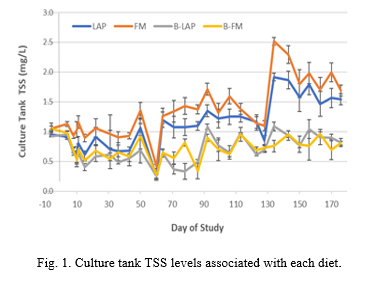COMMERCIAL DEVELOPMENT OF RAS-SPECIFIC DIETS: EVALUATING EFFECTS ON WATER QUALITY AND ATLANTIC SALMON Salmo salar PERFORMANCE
Increas ed investment in land-based , recirculating aquaculture systems (RAS) is driving demand for special ly formulated diets that are compatible with water quality and waste discharge in addition to fish performance . For example, RAS-specific diets must produce intact and settleable fecal material that is less prone to disintegration and release of fine particles and dissolved nutrients . Specialty d iets for the production of market-size Atlantic salmon in RAS are in particular demand, as commercial development of this aquaculture sector has grown rapidly over the last decade.
T o support this industry need, the Freshwater Institute recently partnered with commercial feed supplier Cargill Inc. to evaluate four diets fed to post-smolt Atlantic salmon (1.77 kg initial weight) with in twelve replicated water reuse systems. A 2x2 factorial design was employed to evaluate d iets that: i ) inc luded or exclu ded a proprietary binder-like ingredient (B), and ii) were formulated with either land animal (LAP) or fishmeal-based (FM) proteins (N=3) . Water quality, with focus on total suspended solids (TSS), was comprehensively assessed throughout the 6-month trial , and fish performance metrics were evaluated bimonthly .
A highly significant difference in TSS concentration was detected (P = 0.000) in the culture water of reuse systems relative to inclusion of the binder-like ingredient (Fig. 1) . Trends for increased s olids settleability as measured by TSS levels in the cone-bottom and overtopping flows of settling devices suggested improved fecal stability for diets containing the binder. Significantly lower fine particle (2-30 µm ) counts were also associated with these diets. Fig. 1. Culture tank TSS levels associated with each diet.
A difference in growth as measured by mean salmon weight was detected between treatments (P= 0.000) at each sampling interval , where fishmeal-based diets resulted in faster growth than diets formulated with land animal proteins. Statistical differences in survival and fish health metrics were not found . Overall, t his trial provided data-driven proof-of-concept for the development of a RAS-specific diet for post-smolt Atlantic salmon growing towards market-size.
